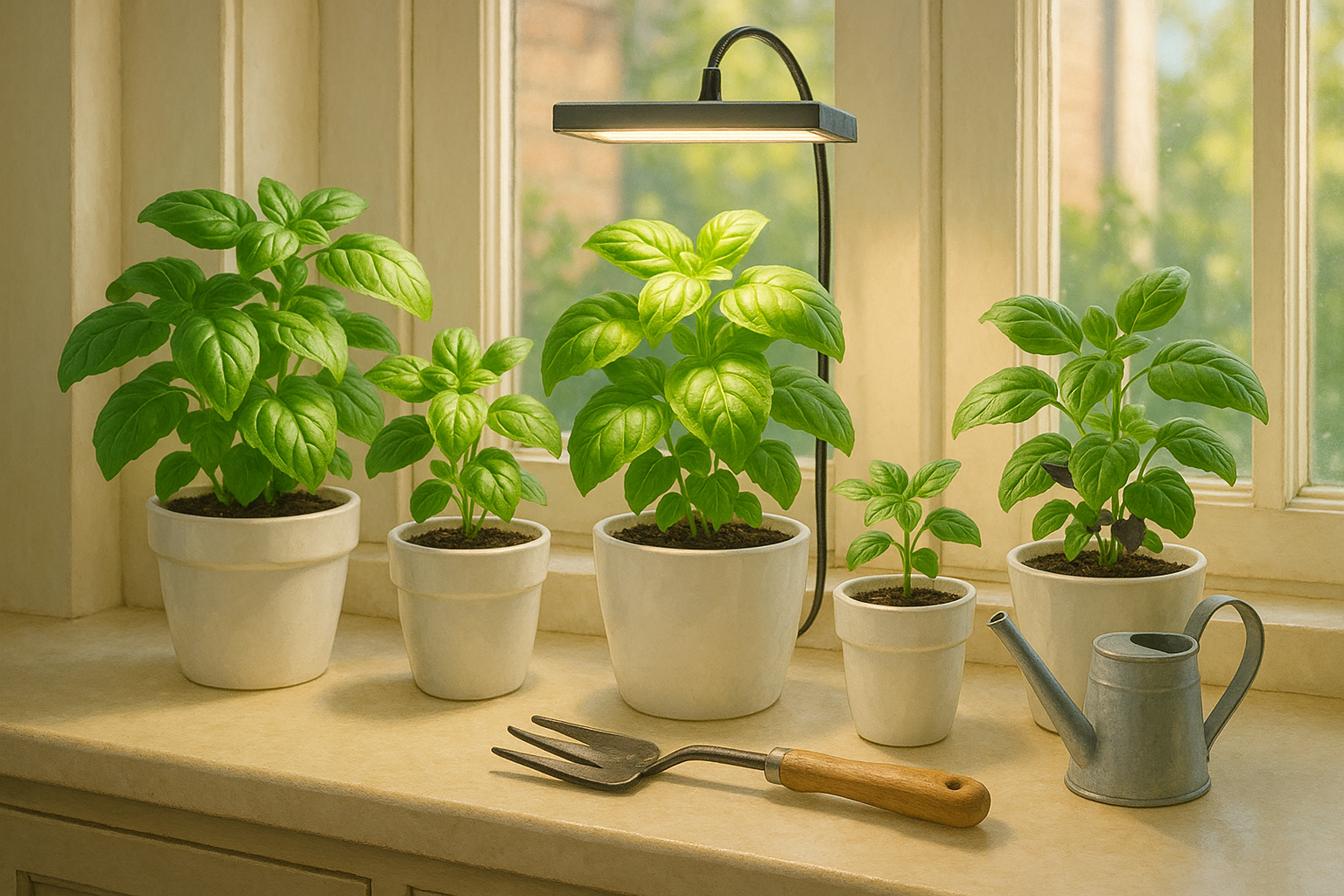Why Grow Basil Year-Round?
Having fresh basil year-round is a culinary game-changer. This fragrant herb instantly elevates dishes, from homemade pesto and pizza to salads and pasta sauces. Unlike dried basil, fresh leaves offer a burst of flavor and aroma that can transform a simple meal into something special.
Beyond taste, basil is rich in antioxidants, vitamin K, and essential minerals, making it a smart addition to your daily diet for immune support and overall wellness. However, keeping basil thriving throughout every season isn’t always easy.
In the summer, basil loves the warmth and sunlight, growing quickly outdoors. But as temperatures drop, especially in winter, basil struggles with cold, dry air and shorter days, often wilting or dying off. Many gardeners find it challenging to keep basil alive during the winter when outdoor conditions aren’t ideal.
That’s where indoor gardening comes in as a practical solution. By using a sunny windowsill or a small grow light, you can create a stable environment for basil to flourish even in the dead of winter. Investing in a few small pots or a countertop hydroponic system lets you snip fresh basil whenever you need it, ensuring your kitchen is always stocked with this versatile, health-boosting herb.
Best Conditions for Basil Growth (Temperature, Light & Humidity)
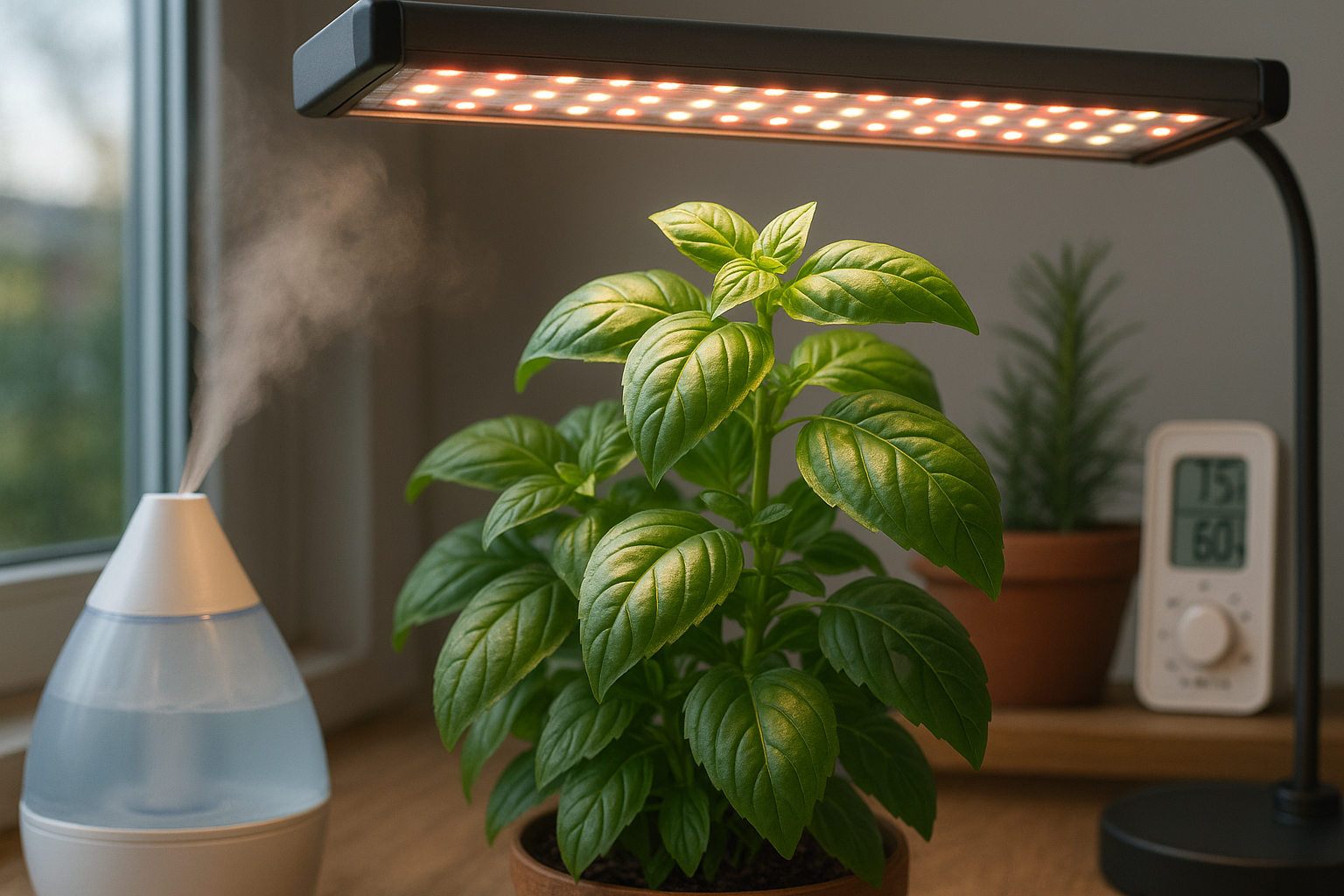
Basil thrives in warm conditions, preferring daytime temperatures between 70–85°F (21–29°C) and staying healthy as long as nighttime temperatures don’t drop below 50°F (10°C). Extreme temperature drops can stunt growth or cause leaves to wilt quickly.
Basil also enjoys moderate humidity levels, ideally between 40–60%, which helps keep its leaves supple and prevents stress. Too little humidity leads to crisp, curling leaves, while too much promotes fungal diseases. Using a small humidifier or grouping plants together can help maintain the right humidity indoors.
Light is equally important: basil needs six to eight hours of direct sunlight each day. Place pots in a sunny south-facing window or, if outdoors, in a spot that stays bright most of the day. In winter, natural daylight often isn’t enough—especially in northern climates—so grow lights can be helpful. Use a full-spectrum LED or fluorescent grow light set a few inches above the plants, running 12 to 14 hours daily to mimic summer sun exposure.
Watch for signs of temperature or light stress: yellowing leaves and stunted growth may indicate cold damage or insufficient light, while scorched or curled leaves can mean too much direct sun or dry air. If you see these symptoms, relocate the plant to a warmer, sheltered spot, adjust indoor heating or humidity, and tweak lighting as needed.
Daily observation and small adjustments—like moving pots when the sunbeam shifts or misting leaves on dry winter days—can make all the difference in keeping basil thriving year-round.
Growing Basil Indoors — Essential Supplies & Setup
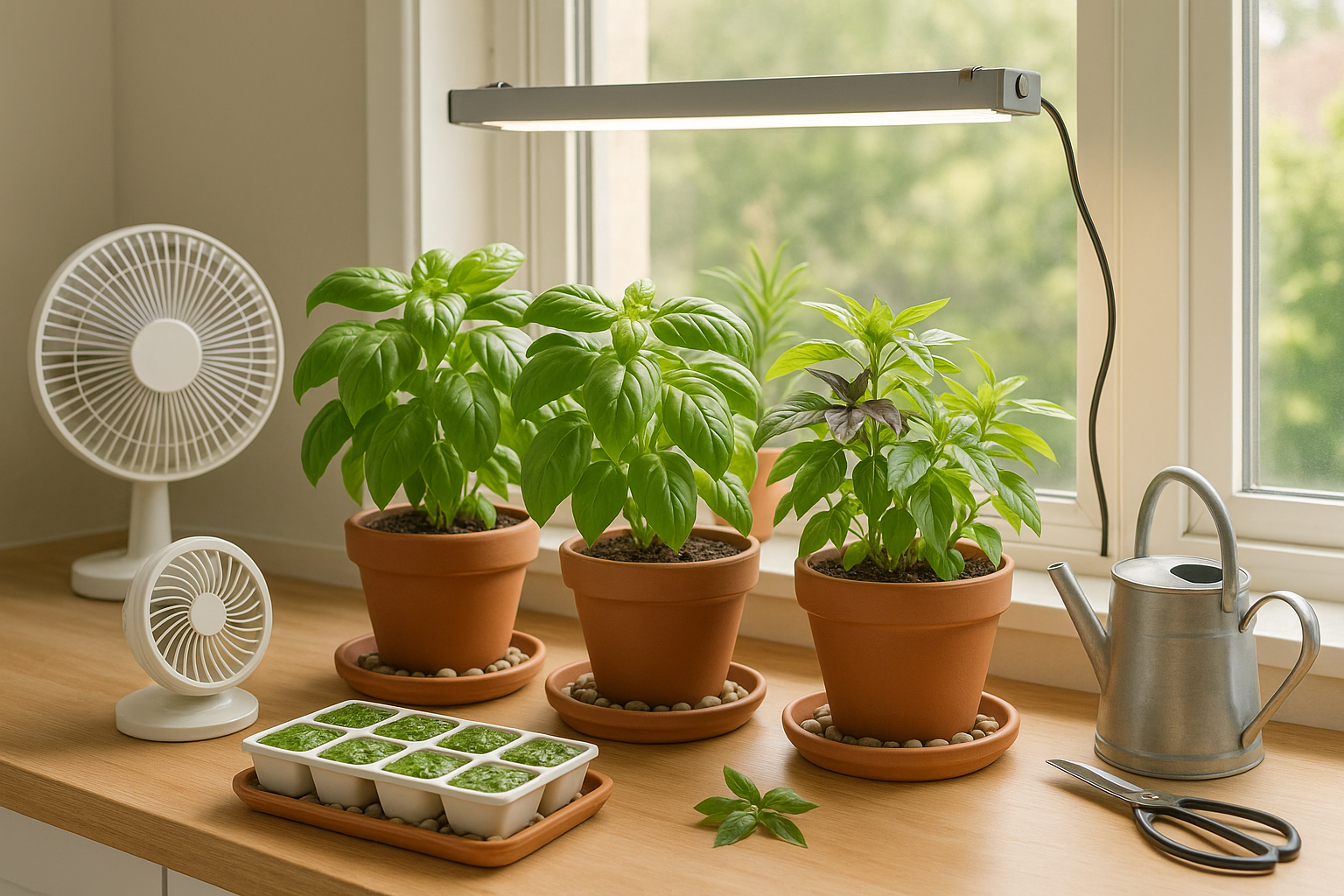
To start growing basil indoors, you’ll need just a few essential supplies. Choose a medium-sized pot (6-8 inches in diameter) with drainage holes to prevent soggy roots—basil hates sitting in water. Use a high-quality, lightweight potting mix designed for indoor herbs, as this promotes airflow and healthy root growth. Place a saucer under your pot to catch excess water and protect your surfaces.
Basil thrives with plenty of light, so pick a sunny south-facing window if possible. If natural sunlight is limited, especially during winter, use an LED grow light (like a 20-watt, full-spectrum bulb) set about 6 inches above your plants. Keep the light on for 12-16 hours per day, and remember to rotate your basil slightly every week so it grows evenly.
Basil prefers a warm, humid environment, but too much moisture and poor airflow can cause fungal issues. To boost humidity, set the pot on a tray filled with pebbles and water, making sure the pot sits just above the water level. Grouping plants together can also create a pocket of higher humidity.
Open a window occasionally for fresh air or run a small fan nearby on low to keep the air moving gently—this helps prevent disease without drying out the leaves. By setting up with these basics, you’ll create an ideal microclimate for flavorful, healthy basil year-round.
Basil Propagation
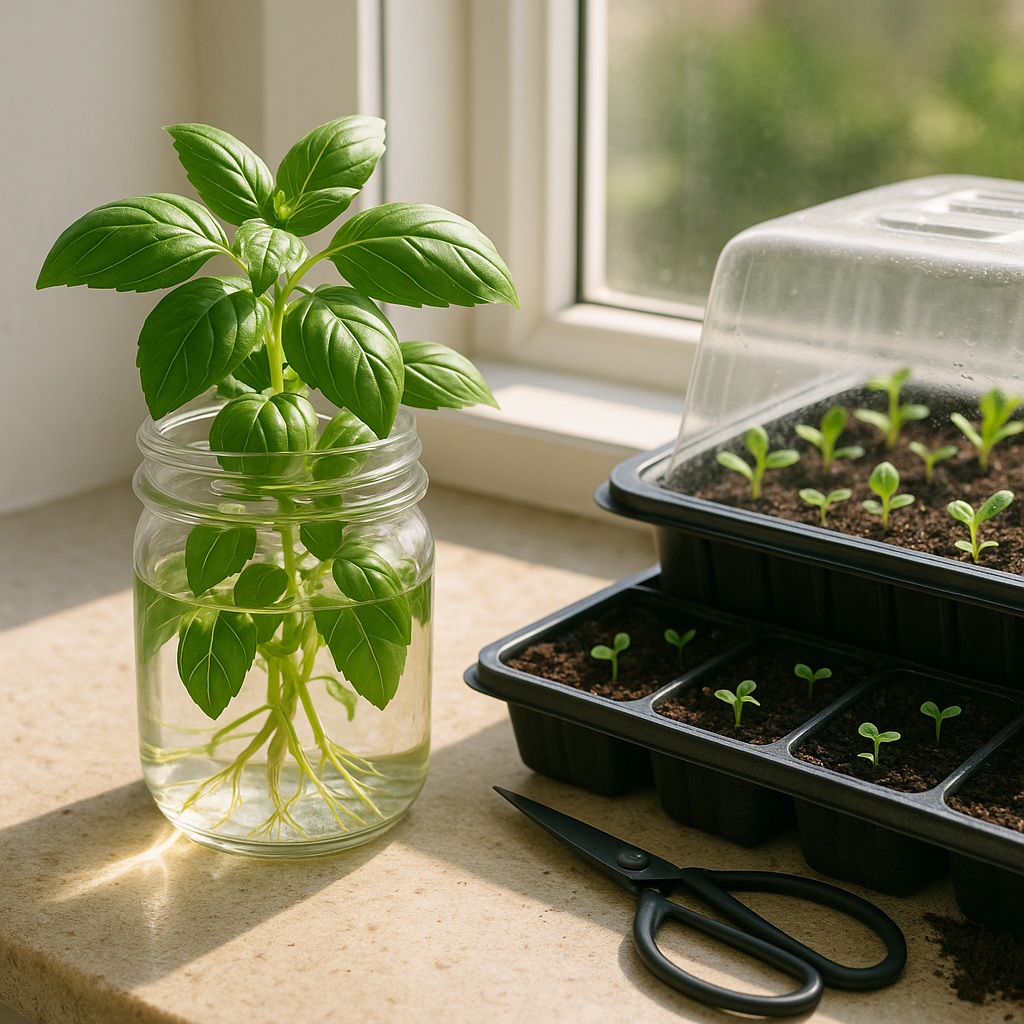
When it comes to year-round basil cultivation, choosing between seeds and cuttings can make a big difference in your gardening experience. Starting basil from seeds is cost-effective and gives you access to a variety of cultivars, but it takes more time—germination can take a week or more, and seedlings need careful watering and enough light to avoid legginess.
Simply sow seeds ¼ inch deep in moist seed-starting mix, keep them warm (around 70°F), and be patient until true leaves appear.
On the other hand, growing basil from cuttings is much faster, letting you clone a mature plant in just 1-2 weeks. Snip a healthy 4-inch stem below a leaf node, strip the lower leaves, and set the cutting in a jar of water—change the water every 2 days and roots will appear quickly.
Transplant rooted cuttings to well-drained soil once they’ve formed several roots, while seedlings should be transplanted when they have at least two sets of true leaves. For both methods, provide bright, indirect sunlight and avoid overwatering.
If you’re short on time, cuttings are perfect for a quick harvest, while seeds offer diversity and strong, disease-resistant starts. Combine both approaches for a continuous crop: start seeds in early spring, then use cuttings from your healthiest plants to boost your supply all year. This way, you’ll always have fresh basil leaves ready for your favorite dishes.
Ongoing Care — Watering, Feeding, & Pruning Tips
When growing basil indoors, especially during winter when humidity drops, it’s important to adjust your watering routine to avoid root rot. Basil prefers slightly moist soil but not soggy conditions. Check the top inch of soil with your finger—if it feels dry, it’s time to water. Always use room-temperature water and pour it directly onto the soil, avoiding the leaves to prevent fungal issues.
Since indoor air tends to be drier in colder months, your basil will likely need less frequent watering than in summer, often just once or twice a week depending on your home’s conditions.
For feeding, use a balanced, water-soluble fertilizer labeled for edibles—something like a 10-10-10 formula—diluted to half strength to avoid over-fertilizing, which can cause weak or leggy plants. Feed your basil every 4–6 weeks during active growth, but skip fertilizer during deep winter when growth naturally slows.
Pruning is the secret to bushy, productive basil. Start when your plant has at least 6–8 leaves. Pinch or snip off the top set of leaves just above a pair of leaf nodes (the spot where leaves grow out from the stem). This encourages the plant to branch out and creates more growing points. Regularly pinch back any flower buds—letting basil flower signals it to stop producing fresh leaves.
With these simple ongoing care practices, your indoor basil can thrive all year, giving you plenty of fresh leaves for your favorite recipes.
Troubleshooting Common Basil Problems in Winter
Winter can be especially tricky for indoor basil, but a few proactive steps can help your plant thrive.
One common issue is leaf drop, usually caused by sudden temperature changes or drafts. Keep basil away from cold windows and ensure the indoor temperature stays above 60°F.
Yellowing or dropping leaves may also result from overwatering—let the top inch of soil dry out before watering again.
Mold can crop up in cool, humid conditions, especially if air circulation is poor. To fix this, avoid misting the leaves, use a small fan nearby, and remove any dead plant material promptly.
For pests like spider mites or aphids, which thrive indoors during winter, wipe leaves with a damp cloth or spray them with a mixture of water and mild dish soap; neem oil also works well as a natural deterrent.
For ongoing productivity, pinch off the tops regularly to encourage bushy growth, and avoid harvesting more than a third of the plant at once.
Aim to harvest in the morning when leaves are most flavorful, and always use clean scissors to minimize stress to the plant.
With these simple adjustments, your indoor basil can keep providing fresh, fragrant leaves all winter long.
Creative Uses for Fresh Basil All Year
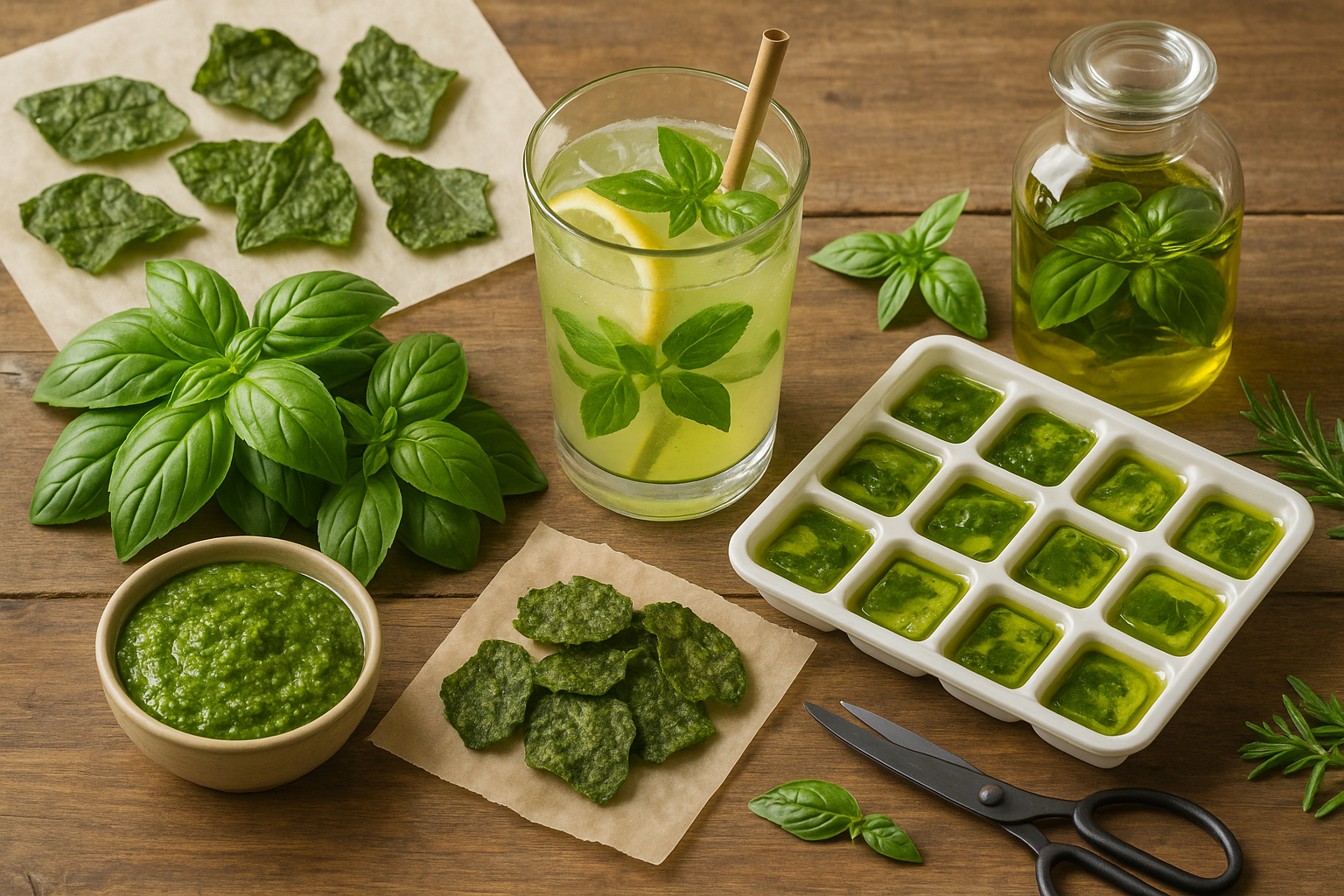
Fresh basil isn’t just for pesto or sprinkling over pasta—there are so many creative ways to enjoy its fragrant, peppery flavor year-round. Try tossing torn basil into fruit salads for a surprising zing, muddling it into cocktails or lemonade, or whirling it into soft butter to spread over warm bread.
Even a handful mixed into scrambled eggs or stirred through warm rice can lift an everyday meal. If you find yourself with more basil than you can use fresh, don’t let it go to waste. Simply chop and freeze basil in ice cube trays with a splash of olive oil—these cubes can be tossed straight into sauces, soups, and sautés later.
For a crunchy snack, bake leaves in the oven at a low temperature for homemade basil chips, or dry the leaves flat in paper towels, then crush and store them in airtight jars.
Infusing olive oil with fresh basil is another quick method; just submerge clean leaves in oil, store in the fridge, and drizzle over Caprese salads or grilled veggies anytime.
With a little effort, you’ll find that your summer basil haul can brighten breakfast, dinner, and even drinks all year long.
